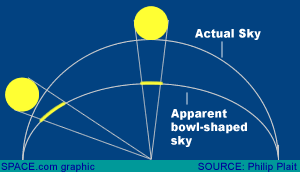This effect is called the Ponzo illusion. Recent experiments have clearly shown that this is the reason for the moon illusion.
Avi Blizovsky

Does a half moon shine half as bright as a full moon?
It is indeed logical to expect that when the moon is half illuminated (in the first or last quarter of the lunar month, also called a half moon), it will shine with half the brightness of a full moon. In fact, if the moon's disc was as flat as a piece of paper or a screen, then its brightness would be the same in every part of its surface and the answer would be correct.
But of course, this is not the case. The moon is spherical, and the amount of sunlight reflected from the moon per lunar unit is less towards the dividing line between the bright and shadowy area. Near and along this line, mountains and cliffs cast countless shadows. This gives the effect that the moon is brighter near these edges, but grayer towards the dividing line. In contrast, when the moon is full, the sun rises almost in a straight line with our line of sight from Earth. That means the sun is behind us when it comes to looking at the moon (it is right behind us during a lunar eclipse). This means that the shadows cast by the mountains on the moon are directly behind the object that created them, and are therefore not visible to our eyes.
Believe it or not, only 2.4 days after the moon's peak brightness and visibility - it takes it to reach half the brightness of the full moon. When the moon is in first or last quarter, it is actually about 1/11 the brightness of a full moon. In fact, in the last quarter it is even dimmer (1/12) - because the more visible flat areas of the "dead" moon are in the bright part.
Misconception: the moon appears large on the horizon because the air acts like a magnifying glass and magnifies the image of the moon
When the moon is on the horizon it looks big and flat even from space. Not just from Earth.
Although we all see the moon, red and swollen, very large as it rises above the horizon. A few hours later, when it was high in the sky, it had shrunk accordingly and looked more normal. Most people also see that the sun behaves similarly and so do the constellations.
It is true that the layer of the atmosphere is thicker in the direction of the horizon. When you look up, you pass through the thinnest part of the atmosphere and the closer you get to the horizon, the more air you need to penetrate to look into space.
However, the air actually compresses the image of the moon, and does not enlarge it. Has anyone noticed the fact that the moon appears flattened right after it rises over the horizon? The reason is that different thicknesses of the air near the horizon disrupt the shape of the moon and reduce the moon from top to bottom. As a result of this effect, the moon appears longer near the horizon. This phenomenon is called the moon illusion, and indeed it is an illusion. You can compare the size of the rising moon with a household object, say a crayon at an arm's distance from the eye, and repeat the operation a few hours later. You can notice that the size has not changed significantly. The illusion is indeed convincing but not real.
What happens here is that the brain translates the sky as if it is much further away on the horizon, and closer at the zenith (directly overhead). This is not surprising if we look at the sky on a cloudy day and the clouds are only a few kilometers above us, but near the horizon they may be hundreds of kilometers from us. The moon, when it is above the horizon, translates to our brain as very distant. Since it appears the same size when it is at the zenith, the brain translates this as physically larger. Otherwise, the distance would actually make it seem smaller.
